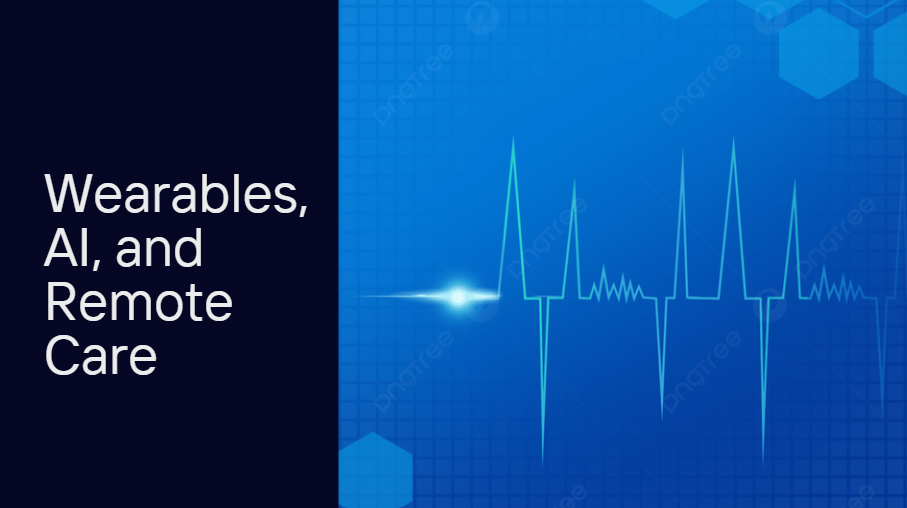The health sector is undergoing a profound transformation. Wearables, artificial intelligence (AI), and remote care technologies are reshaping how healthcare is delivered, accessed, and experienced. In the emerging health tech ecosystem, patients are no longer just passive recipients of care — they are active participants, empowered by smart devices and real-time data.
This shift marks a turning point, with health moving from episodic, hospital-centered care to continuous, personalized, and decentralized health management.
The Rise of Wearables in Health
Wearable technology has exploded in popularity, initially driven by fitness enthusiasts but rapidly expanding into clinical and chronic care management.
Today’s wearables include devices like:
Smartwatches (e.g., Apple Watch, Fitbit, Garmin)
Continuous glucose monitors (CGMs)
Wearable ECG monitors
Blood pressure monitors
Smart rings and patches
These devices go beyond step counts, offering sophisticated biometrics such as:
Heart rate variability
Blood oxygen saturation
Sleep quality
Stress levels
Blood sugar trends
Critically, many wearables now achieve medical-grade accuracy, making them valuable tools for clinicians managing chronic conditions like diabetes, hypertension, and arrhythmias.
Key drivers behind wearable adoption include:
Rising consumer interest in preventive health
Employer wellness programs
Integration with telehealth platforms
Advances in miniaturization and battery life
As wearables collect continuous data streams, they open the door to early intervention, risk prediction, and personalized treatment.
Artificial Intelligence: The Brain Behind Smart Health
AI sits at the heart of the new health tech ecosystem, interpreting the massive volumes of data generated by wearables and remote monitoring devices.
Applications of AI in health tech include:
Predictive Analytics: Identifying patients at risk of conditions like stroke, heart failure, or depression.
Image Analysis: AI radiology tools detecting tumors, fractures, or anomalies faster than traditional methods.
Virtual Health Assistants: Chatbots offering medication reminders, mental health check-ins, and basic triage.
Clinical Decision Support: AI tools that aid doctors in making faster, evidence-based diagnoses.
Machine learning models become smarter over time, continuously improving their predictive power with more data.
In the context of remote care, AI helps triage patients, flag abnormalities, and streamline workflows, allowing human clinicians to focus on higher-level care.
For patients, this can mean earlier diagnoses, fewer hospital visits, and better health outcomes.
Remote Care: Healthcare Without Walls
Remote care — also known as virtual care or telehealth — dramatically expanded during the COVID-19 pandemic, becoming a permanent feature of healthcare.
Today’s remote care offerings include:
Virtual consultations with doctors and specialists
Remote patient monitoring (RPM) programs
At-home diagnostic kits
Digital physical therapy and rehabilitation apps
Paired with wearables and AI, remote care becomes even more powerful. Patients can measure key health metrics at home, have AI flag concerning patterns, and consult with a clinician via video without ever stepping into a hospital.
Benefits of remote care include:
Increased Access: Especially for rural, elderly, and mobility-limited populations.
Reduced Costs: Fewer emergency room visits and hospital admissions.
Patient Convenience: No travel, waiting rooms, or time off work needed.
Better Chronic Disease Management: Continuous monitoring leads to proactive interventions.
Healthcare providers increasingly offer hybrid care models, blending in-person and remote services to provide the best of both worlds.
Challenges in Building the New Ecosystem
While the integration of wearables, AI, and remote care is promising, several challenges remain:
Data Privacy and Security: Sensitive health data must be protected against breaches and misuse.
Interoperability: Devices, platforms, and electronic health records (EHRs) must communicate seamlessly.
Health Equity: Ensuring access to technology for underserved populations.
Regulation and Validation: Verifying the clinical efficacy and safety of new tools.
User Engagement: Sustaining long-term use of devices and apps, especially among older adults.
Navigating these challenges will be critical to ensuring that the new health tech ecosystem benefits all stakeholders — patients, providers, and payers.
Investment Trends in Health Tech
Health tech investment continues to surge, with wearables, AI, and remote care attracting significant capital.
Key trends include:
Corporate M&A: Tech giants like Apple, Google, and Amazon deepening their healthcare footprints.
Startup Growth: Specialized companies focused on remote monitoring, AI diagnostics, and digital therapeutics raising record venture capital rounds.
Partnership Models: Health systems and insurers partnering with tech companies to integrate new tools into care delivery.
According to recent industry reports:
The global digital health market is expected to exceed $650 billion by 2030.
Remote patient monitoring alone could grow to over $130 billion by 2028.
AI in healthcare could contribute over $100 billion in economic value annually by 2030.
Investors are particularly keen on companies that combine clinical validation with strong user engagement metrics — demonstrating real-world outcomes at scale.
The Patient at the Center
The ultimate winner in the new health tech ecosystem is the patient.
With access to personal health data, AI-powered insights, and remote care options, patients are empowered to:
Understand their own health better
Take proactive actions to prevent illness
Manage chronic conditions more effectively
Receive faster, more convenient care
Healthcare is shifting from a reactive model (“treat when sick”) to a proactive model (“monitor and prevent before illness escalates”).
This shift is fundamental to building a more sustainable, affordable, and humane healthcare system.
The Road Ahead
The future of healthcare is one where:
Wearables detect subtle physiological changes before symptoms appear.
AI predicts disease risks months or even years ahead.
Remote care becomes the default for routine check-ups and chronic disease management.
Hospitals focus on complex, high-acuity cases, while everyday health happens at home.
As technology advances, expect to see more sophisticated integrations, such as:
Smart clothing embedded with health sensors
Voice-activated diagnostics through smart home devices
AI-driven personal health coaches
Blockchain-secured health records for seamless, secure data sharing
However, the future will also demand strong ethical governance, equity-focused strategies, and patient-centered design to ensure that innovation leads to better health for all — not just for the tech-savvy or wealthy few.



